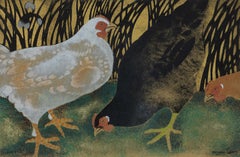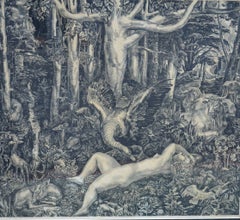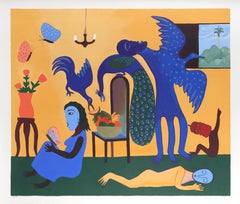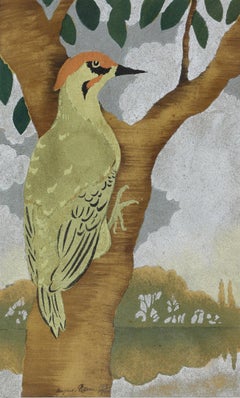Stencil Animal Prints
to
1
Overall Width
to
Overall Height
to
3
2
1
1
1
1
1
1
1
1,111
28
6
3
2
1
1
Style: Post-Impressionist
Medium: Stencil
Three Hens by Georges Manzana Pissarro - Animal stencil
Located in London, GB
Three Hens by Georges Manzana Pissarro (1871-1961)
Pochoir
31.8 x 48.3 cm (12 ½ x 19 inches)
Signed with Estate stamp and épreuve d'état
Provenance
Private Collection, London
Artis...
Category
19th Century Post-Impressionist Stencil Animal Prints
Materials
Stencil
Related Items
Leda and the Swan
Located in West Hollywood, CA
Presenting a monumental original etching by French artist Albert Decaris. Decaris won many honors in France during his extensive career.
"Leda and the Swan", depicts the mythologi...
Category
1920s Stencil Animal Prints
Materials
Etching
El reposo
Located in Miami, FL
Beautiful Serigraph print on paper by the Cuban artist Manuel Mendive.
El Reposo, 2021
Lithograph
23,5 x 29 in
Ed. 10 of 100
Signed and numbered by the artist.
Manuel Mendive is an ...
Category
21st Century and Contemporary Contemporary Stencil Animal Prints
Materials
Laid Paper, Screen
Mike Mitchell - Western Scrub-Jay - Artist Edition - Contemporary Artist
Located in Asheville, NC
Mike Mitchell - Western Scrub-Jay - Artist Edition - Contemporary Artist
Edition Details
Year: 2016
Class: Art Print
Status: Official
Technique: Giclee
Paper: Cotton rag
Size: 8 X 10
Markings: Signed
Manufacturer: Static Medium
About Artist:
Mike Mitchell is an American artist known for his pop surrealism and for leading the online grassroots movement in supporting Conan O'Brien during the 2010 Tonight Show conflict. He designed the "I'm with Coco" poster, which was based on a photo, that went viral on the internet in January 2010. The poster has been widely circulated and displayed on the web and at various rallies during the 2010 Tonight Show conflict, and afterwards for O'Brien's The Legally Prohibited from Being Funny on Television Tour. He also designed a poster in response to the Deepwater Horizon oil spill...
Category
2010s Contemporary Stencil Animal Prints
Materials
Giclée
The Book, Silkscreen, S/N from the 1776-1976: USA Bicentennial Prints portfolio
By Will Barnet
Located in New York, NY
Will Barnet
The Book, from the 1776 USA 1976: Bicentennial Prints portfolio, 1975
Silkscreen in colors on white Arches wove paper
Pencil signed, titled and numbered 65/75 on the fron...
Category
1970s Contemporary Stencil Animal Prints
Materials
Screen
Mike Mitchell - Himalayan Bulbul - Contemporary Artist
Located in Asheville, NC
Mike Mitchell - Himalayan Bulbul - Contemporary Artist
The Himalayan bulbul (Pycnonotus leucogenys), or white-cheeked bulbul, is a species of songbird i...
Category
2010s Contemporary Stencil Animal Prints
Materials
Giclée
Lithograph Lady Rider Woman on a Horse Marie Laurencin French Post Impressionist
Located in Surfside, FL
Marie Laurencin (French, 1883-1956)
Lithograph of a colored pencil drawing depicting a woman wearing a hat and riding horseback side saddle,
Edition "37/115" to lower left and hand signed "Laurencin" in pencil to lower right, with a cloth mat and housed in a silvered wood frame.
Dimensions: Image, 12" H x 16" W; frame, 19.75" H x 23.5" W x 1.5" D.
Marie Laurencin (1883 – 1956) was a French painter and printmaker. She became an important figure in the Parisian avant-garde as a member of the Cubists associated with the Section d'Or.
Laurencin was born in Paris, where she was raised by her mother and lived much of her life. At 18, she studied porcelain painting in Sèvres. She then returned to Paris and continued her art education at the Académie Humbert, where she changed her focus to oil painting.
During the early years of the 20th century, Laurencin was an important figure in the Parisian avant-garde. A member of both the circle of Pablo Picasso, and Cubists associated with the Section d'Or, such as Jean Metzinger, Albert Gleizes, Robert Delaunay, Henri le Fauconnier and Francis Picabia, exhibiting with them at the Salon des Indépendants (1910-1911) and the Salon d'Automne (1911-1912), and Galeries Dalmau (1912) at the first Cubist exhibition in Spain. She became romantically involved with the poet Guillaume Apollinaire, and has often been identified as his muse. In addition, Laurencin had important connections to the salon of the American expatriate and lesbian writer Natalie Clifford Barney. She had relationships with men and women, and her art reflected her life, her "balletic wraiths" and "sidesaddle Amazons" providing the art world with her brand of "queer femme with a Gallic twist."
Laurencin's oeuvre include painting, watercolor paintings, drawing, and prints. She is known as one of the few female Cubist painters, with Sonia Delaunay, Marie Vorobieff, and Franciska Clausen...
Category
Mid-20th Century Post-Impressionist Stencil Animal Prints
Materials
Lithograph
$1,800
H 19.75 in W 23.5 in
Mike Mitchell - Red-Winged Blackbird - Contemporary Artist
Located in Asheville, NC
Mike Mitchell - Red-Winged Blackbird - Contemporary Artist
Edition Details:
Year: 2014
Class: Art Print
Status: Fan Art
Released: 09/20/14
Run: 300
Technique: Giclee
Size: 8 X 10
Ma...
Category
2010s Contemporary Stencil Animal Prints
Materials
Giclée
Mike Mitchell - Desert Cardinal - Artist Edition. - Contemporary Artist
Located in Asheville, NC
Mike Mitchell - Desert Cardinal - Artist Edition - Contemporary Artist
Edition Details
Year: 2015
Class: Art Print
Status: Official
Run: 95
Techn...
Category
2010s Contemporary Stencil Animal Prints
Materials
Giclée
YES! pencil signed and numbered homemade print by world renowned British artist
By Tracey Emin
Located in New York, NY
Tracey Emin
YES!, 2012
Home made color inkjet print
11 3/4 × 16 1/2 inches
Edition 111/150
Pencil signed, numbered 111 and dated 2012 recto; bears Emin International stamp on the ver...
Category
2010s Contemporary Stencil Animal Prints
Materials
Handmade Paper, Inkjet
$5,950
H 11.75 in W 16.5 in
In Praise of Prairie Dogs (19-325), 11 Color lithograph, Signed/N Judy Chicago
By Judy Chicago
Located in New York, NY
Judy Chicago
In Praise of Prairie Dogs (19-325), 2019
11 Color Lithograph on light blue Pescia paper
Hand signed, dated and numbered from the limited edition of 95 on the front
22 × ...
Category
2010s Feminist Stencil Animal Prints
Materials
Lithograph
Kiki Smith, Tattoo Print, silkscreen and ink transfer on wove paper, S/N, Framed
By Kiki Smith
Located in New York, NY
Kiki Smith
Tattoo Print, 1995
Silkscreen and ink transfer on wove paper
Signed, dated 1995 and numbered 96/100 in graphite pencil on the front
Another example of this edition is in t...
Category
1990s Contemporary Stencil Animal Prints
Materials
Ink, Screen
$7,000
H 24.5 in W 36 in D 2 in
Nixon + Spiro - Zero, Extremely rare 1968 political poster offset lithograph
Located in New York, NY
Unknown Artist
Nixon + Spiro - Zero, 1968
Extremely rare vintage 1960s Offset lithograph poster
28 × 22 inches
Publisher
Published by Joe A. Kennedy; printed by Provo Press
Unframed,...
Category
1960s Modern Stencil Animal Prints
Materials
Lithograph, Offset
$2,000
H 28 in W 22 in
Previously Available Items
The Green Woodpecker by Georges Manzana Pissarro - Animal stencil
Located in London, GB
*UK BUYERS WILL PAY AN ADDITIONAL 20% VAT ON TOP OF THE ABOVE PRICE
The Green Woodpecker by Georges Manzana Pissarro (1871-1961)
Pochoir
31 x 47 cm (12 ¹/₄ x 18 ¹/₂ inches)
Signed w...
Category
1920s Post-Impressionist Stencil Animal Prints
Materials
Stencil
Stencil animal prints for sale on 1stDibs.
Find a wide variety of authentic Stencil animal prints available on 1stDibs. While artists have worked in this medium across a range of time periods, art made with this material during the 21st Century is especially popular. If you’re looking to add animal prints created with this material to introduce a provocative pop of color and texture to an otherwise neutral space in your home, the works available on 1stDibs include elements of blue and other colors. There are many well-known artists whose body of work includes ceramic sculptures. Popular artists on 1stDibs associated with pieces like this include Salvador Dalí, Georges Henri Manzana Pissarro, Banksy, and (after) Max Ernst. Frequently made by artists working in the Surrealist, Post-Impressionist, all of these pieces for sale are unique and many will draw the attention of guests in your home. Not every interior allows for large Stencil animal prints, so small editions measuring 0.5 inches across are also available
Recently Viewed
View AllMore Ways To Browse
Manetti Saverio
Natural History Museum Vintage Prints
Penguin Lithograph
Peter Klucik
Pheasant Engraving
Picasso Dove Of Peace
Picasso Le Taureau
Picasso Rooster
Ronald Smith
Rooster Print Picasso
Salvador Dali Argus
Salvador Dali Unicorn
Sam Savitt
Shore Bird Print
Space Elephant Dali
Szabolcs Bozo
The Toad Picasso
Vintage Forest Service Posters



